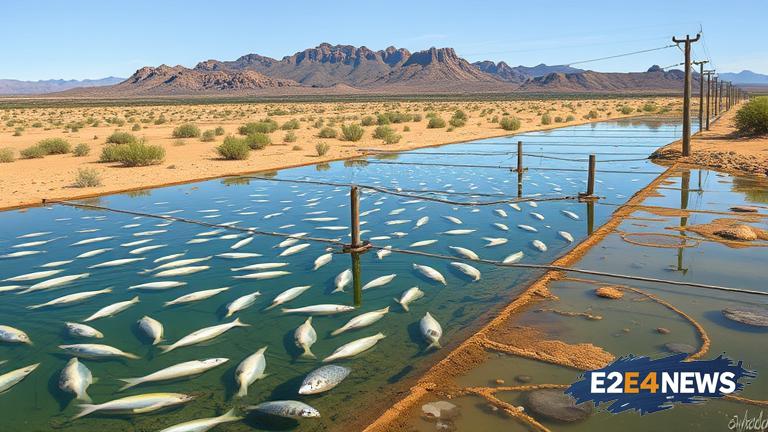In the heart of the Arizona desert, a fish farm has been making waves with its innovative approach to raising fish. However, the farm’s water usage has sparked a heated debate among locals and environmentalists. The farm, which uses a recirculating aquaculture system, claims to be a sustainable and water-efficient way to produce fish. But critics argue that the farm’s water usage is still too high, especially in a region where water is already a scarce resource. The farm’s owners argue that their system uses significantly less water than traditional farming methods, and that the water is constantly being recycled and reused. However, others point out that the farm’s water usage is still substantial, and that the water is being taken from the local aquifer. The debate has raised questions about the sustainability of fish farming in the desert, and whether it is a viable solution for food production in the region. Some argue that fish farming is a more sustainable option than traditional livestock farming, as it requires less land and water. However, others argue that the environmental impacts of fish farming, including the use of antibiotics and the discharge of waste, outweigh any potential benefits. The Arizona desert is already facing significant water challenges, with the Colorado River, which supplies much of the region’s water, facing historic lows. The farm’s water usage has also raised concerns about the impact on local wildlife, including the endangered Gila trout. The fish farm has been praised for its innovative approach to sustainable food production, but critics argue that more needs to be done to address the water usage concerns. The farm’s owners have stated that they are committed to sustainability and are working to reduce their water usage even further. However, the debate highlights the complex issues surrounding water usage in the Arizona desert, and the need for careful consideration and planning when it comes to sustainable food production. The use of recirculating aquaculture systems is becoming increasingly popular in the US, with many farms adopting the technology as a way to reduce their environmental impact. However, the Arizona desert presents unique challenges, including extreme temperatures and limited water resources. The fish farm has been working with local universities and research institutions to develop new technologies and strategies for reducing water usage. The farm’s owners believe that their approach can be a model for sustainable food production in the desert, but others argue that more research is needed to fully understand the environmental impacts. The debate over the fish farm’s water usage has sparked a wider conversation about the sustainability of food production in the Arizona desert. As the region continues to grow and develop, it is likely that the demand for sustainable food production will only increase. The fish farm’s innovative approach has raised important questions about the role of technology in sustainable food production, and the need for careful consideration of environmental impacts. The use of recirculating aquaculture systems has the potential to reduce water usage and minimize environmental impacts, but it is not without its challenges. The Arizona desert is a unique and fragile ecosystem, and any attempts to develop sustainable food production systems must take into account the region’s limited resources and extreme climate. The fish farm’s owners are committed to ongoing research and development, and are working to address the concerns raised by critics. However, the debate highlights the need for a nuanced and multifaceted approach to sustainable food production in the Arizona desert. The region’s water challenges are complex and multifaceted, and will require careful consideration and planning to address. The fish farm’s innovative approach is an important step towards sustainable food production, but it is only one part of a larger conversation about the future of food production in the Arizona desert.
